How To Hold A Tattoo Gun: Detailed Guide
Whether you’re a beginner or an experienced artist, learning how to properly hold a tattoo gun can make a significant difference in the quality of your work. Holding the machine correctly not only ensures comfort and control but also reduces the risk of hand fatigue and injury. So, the question is, how to hold a tattoo gun?
First off, make sure you have a comfortable grip and hold the gun at a slight angle to the skin. Keep your hand steady and move the gun in a smooth motion to create clean lines and shading. Remember to take breaks and stretch your hand to avoid cramping. With patience and persistence, you can perfect your tattoo gun-holding skills and create stunning body art.
In this article, we’ll explore the essential steps and techniques to hold a tattoo gun correctly, giving you the confidence to create beautiful, lasting works of art.
Hand Position While Holding Your Tattoo Gun

When it comes to tattooing, the hand position while holding the tattoo gun is one of the most important aspects to consider, as it can affect the outcome of the tattoo design and the comfort of the tattoo artist.
Here is an elaboration on the recommended hand position for holding a tattoo gun:
Grip
The grip of the tattoo gun should be held firmly in the hand, but not so tight that it causes hand fatigue or discomfort. The grip should also allow for a comfortable hold without slipping or rotating.
Thumb placement
The thumb should be placed on the back of the tattoo gun grip, opposite to the needle tip. This allows for more control and precision while tattooing, as the thumb, can guide the movement of the gun.
Index finger placement
The index finger should be placed on the trigger button of the tattoo gun. It’s essential to maintain consistent pressure while tattooing. You can adjust the pressure to control the speed and depth of the needle, but it’s crucial to keep the pressure steady.
Middle finger placement
The middle finger should be placed on the front of the grip, opposite to the thumb. It supports the grip of the tattoo gun and allows for more control over the movement of the gun.
The ring finger and pinky finger placement
The ring finger and pinky finger should be tucked into the palm of the hand. This allows for a stable base for the hand to hold the gun, reducing hand fatigue.
Correct Angle To Hold A Tattoo Gun
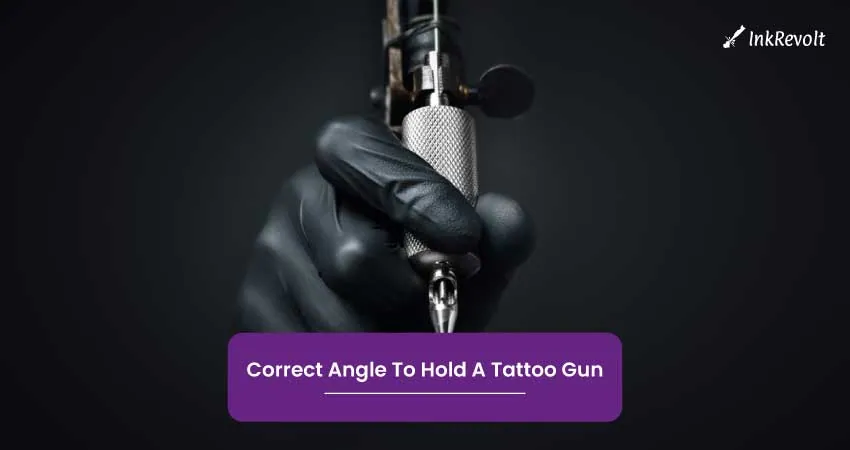
Holding a tattoo gun at the correct angle is essential for achieving good results and preventing any potential injuries. Here are some steps to follow when holding a tattoo gun:
- Grip: Hold the machine with a firm grip using the dominant hand. The grip should be comfortable and firm enough to avoid slipping, but not too tight to cause fatigue.
- Angle: Hold the machine at a 45-degree angle. This angle helps the needle to penetrate the skin more effectively, allowing the ink to penetrate more deeply.
- Depth: Ensure that the needle depth is correct for the area being tattooed. For example, shallow needle depth is ideal for outlining, while deeper needle depth is required for shading and filling.
- Movement: Move the tattoo gun in a smooth, steady motion. Avoid jerking or stopping the gun, as this can cause uneven lines and blotchy areas.
- Resting: Take regular breaks to rest your hand and prevent fatigue. You can also switch hands if needed.
Understanding The Parts Of A Tattoo Gun

Understanding the various parts of a tattoo gun is essential for anyone who wants to learn the art of tattooing.
Frame
The frame is the backbone of the tattoo gun. It holds all the components together and provides stability and support. Frames can be made of various materials such as steel, aluminium, or plastic.
Coils
Coils are electromagnetic components that power the tattoo gun. They are made of copper wire wrapped around an iron core. When the tattoo gun is turned on, the coils create a magnetic field that moves the armature bar up and down.
Armature Bar
The armature bar is a metal rod that connects the needle to the coils. When the coils are activated, they move the armature bar up and down, causing the needle to puncture the skin.
Front Binding Post
The front binding post is a metal screw that holds the front coil in place. It is attached to the top of the frame and connects to the power supply.
Rear Binding Post
The rear binding post is a metal screw that holds the rear coil in place. It is attached to the bottom of the frame and connects to the power supply.
Capacitor
The capacitor is a small cylinder-shaped component that helps regulate the power output of the tattoo gun. It stores electrical energy and releases it when needed.
Contact Screw
The contact screw is a metal screw that controls the depth of the needle. When the screw is turned, it adjusts the distance between the front coil and the armature bar, which affects the length of the needle stroke.
Needle
The needle is part of the tattoo gun that actually pierces the skin and deposits ink. Needles come in various sizes and configurations, depending on the type of design being created.
Tube
The tube is a plastic or metal sleeve that holds the needle in place. It is inserted into the grip and can be adjusted to control the depth of the needle.
Grip
The grip is part of the tattoo gun that the artist holds onto while working. It is usually made of rubber or silicone and is designed to provide a comfortable and secure grip. The grip affects the artist’s control over the needle, as it determines how firmly the needle is held in place. A loose grip can lead to shaky lines and uneven shading, while a tight grip can cause hand fatigue and discomfort.
How To Hold A Tattoo Machine When Lining
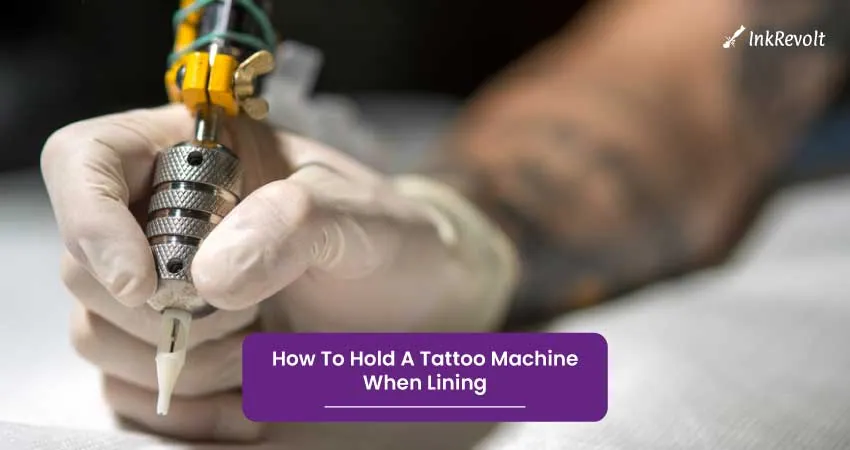
Holding a tattoo machine when lining requires a steady hand and a good understanding of the proper technique. With practice and patience, you can develop the skills needed to create beautiful, high-quality tattoos that will last a lifetime.
Here is how to hold a tattoo machine when lining:
- Begin by ensuring that your tattoo machine is properly set up and that you have sterilized the area you will be tattooing.
- Hold the tattoo machine in your dominant hand with the grip between your thumb and index finger.
- Your middle finger should rest on the back of the machine while your ring and little finger should be curled around the front.
- Use your non-dominant hand to hold the skin taut and in place.
- Position the needle at a 45-degree angle to the skin and start making small, controlled strokes to create the outline of the tattoo.
- As you work, ensure that the needle is always perpendicular to the skin to avoid causing unnecessary damage.
- Keep your hand steady and maintain a consistent pace to ensure that the line is smooth and even.
- Remember to take breaks as needed to avoid hand fatigue and to allow the client to rest.
- Once you have finished the outline, carefully clean the area with antiseptic and move on to shading and colouring as needed.
Make Holding Your Machine Easier by Wrapping Your Grips

If you are using a machine for an extended period of time, it can become uncomfortable to grip the handle or surface. Wrapping your grips is an excellent solution to this problem. It can provide added comfort and reduce the risk of developing blisters or calluses.
Here are some steps you can follow to wrap your machine grips:
Choose the Right Material
There are various materials available that can be used to wrap your machine grips, such as foam, rubber, or leather. You should choose a material that is comfortable to grip and does not slip easily.
Measure the Length
Measure the length of the grip area that you want to wrap. This will give you an idea of how much material you will need.
Cut the Material
Cut the material into strips that are long enough to wrap around the grip area. Make sure to cut the strips to the appropriate width, so they cover the entire grip area.
Secure the Material
Start by securing one end of the material to the grip with tape. Wrap the material tightly around the grip, ensuring that there are no wrinkles or gaps. You can use tape to secure the end of the material or use glue or stitching to keep it in place.
Finish the Wrap
Once you have wrapped the entire grip, you can use tape, glue, or stitching to secure the end of the material. Trim off any excess material, and ensure that the wrap is tight and secure.
Things To Avoid While Holding Your Tattoo Gun
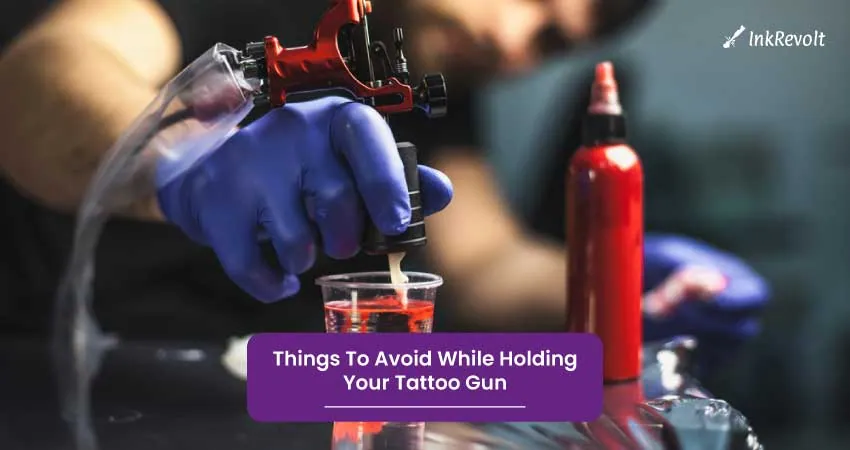
Here are some general tips on things to avoid while using a tattoo gun:
- Don’t hold the tattoo gun too tightly: It’s important to have a firm grip on the tattoo gun, but holding it too tightly can cause your hand to cramp up, leading to shaky and uneven lines.
- Avoid resting your hand on the skin: While tattooing, avoid resting your hand on the skin. This can cause the skin to stretch and distort, making it difficult to create precise and clean lines.
- Don’t use a dull needle: Using a dull needle can cause unnecessary pain to the client and can lead to uneven lines and blotchy shading.
- Avoid using too much pressure: It’s important to use just the right amount of pressure when tattooing. Too much pressure can cause the needle to puncture the skin too deeply, while too little pressure can cause the ink to not properly penetrate the skin.
- Don’t use contaminated equipment: Make sure to properly sterilize all equipment and change needles between clients to avoid the spread of infections and diseases.
- Avoid drinking alcohol or using drugs while tattooing: Tattooing requires concentration and precision, so it’s important to avoid any substances that can impair your judgment or motor skills.
Additional Tips To Hold A Tattoo Gun For Clean, Consistent Lines
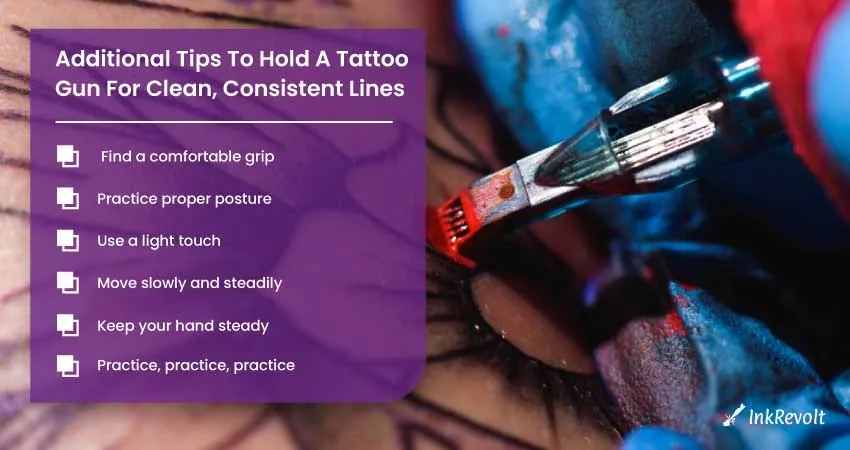
A step-by-step guide on how to hold a tattoo gun for clean, consistent lines is given below:
Find a comfortable grip
Start by finding a comfortable grip that feels natural to you. Experiment with different grips until you find one that feels secure and allows you to maintain control of the machine.
Practice proper posture
Stand or sit up straight with your arms relaxed and close to your body. Avoid leaning over the tattoo area as this can cause unnecessary strain on your back, neck, and shoulders.
Use a light touch
Use a light touch when holding the tattoo gun to prevent the needle from penetrating too deep into the skin. A light touch will also help you to maintain control of the needle and create clean, consistent lines.
Move slowly and steadily
Move the tattoo gun slowly and steadily across the skin, keeping the needle at a consistent angle and depth. Avoid jerky or fast movements, as these can cause uneven lines or damage the skin.
Keep your hand steady
Keep your hand steady while holding the tattoo gun to prevent shaking or wobbling. This will help you to create straight, even lines and prevent mistakes.
Practice, practice, practice
Like any skill, tattooing takes practice to master. Take the time to practice holding the tattoo gun and creating clean, consistent lines on a practice skin or fruit before attempting to tattoo a person.
Read Also: Best Tattoo Guns
What’s The Right Way Of Adjusting The Needle Depth And Speed?
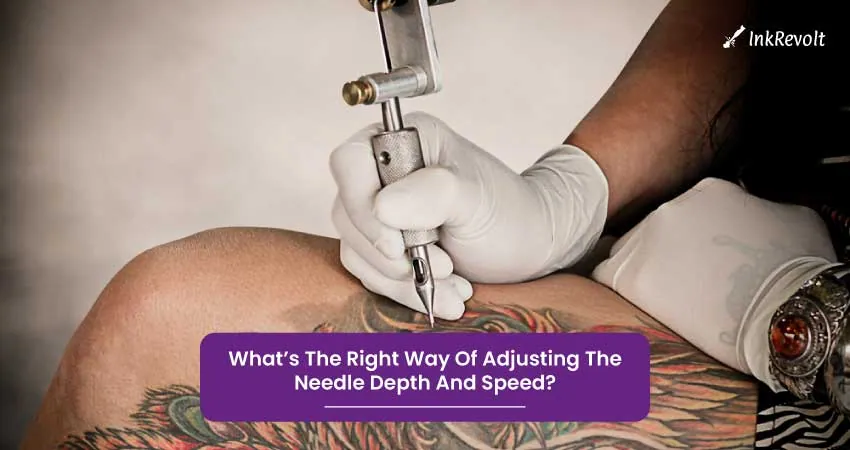
Adjusting needle depth and speed is an unavoidable aspect of tattooing that requires precision and care to avoid causing unnecessary pain, scarring, or infections. Let’s go through some guidelines for adjusting needle depth and speed the right way:
Needle Depth
- Before starting the tattooing process, you need to check the needle depth, which should be based on the skin type and the area being tattooed.
- Adjust the needle depth by turning the needle bar and needle tube in the machine to move the needle up or down.
- For thinner or sensitive skin, you need to adjust the needle depth to a lower level to avoid causing too much damage to the skin. Conversely, for thicker skin or areas where more ink needs to be deposited, you may need to adjust the needle depth to a higher level.
- Once the needle depth is set, check it by making a few light lines on the skin to ensure it is not too deep or too shallow.
Speed
- The tattoo machine’s speed needs to be adjusted based on the design, needle grouping, and the client’s skin type.
- Start by adjusting the machine’s speed to a slower setting and gradually increase the speed as needed.
- For a smoother and more consistent tattooing experience, you need to adjust the speed based on the design and needle grouping. Smaller needles and intricate designs need to be done at a slower speed, while larger needles and shading require a faster speed.
- Make sure to test the machine’s speed by creating a few test lines on the skin to ensure it is not too fast or too slow.
Understanding The Weight Distribution Of The Tattoo Gun
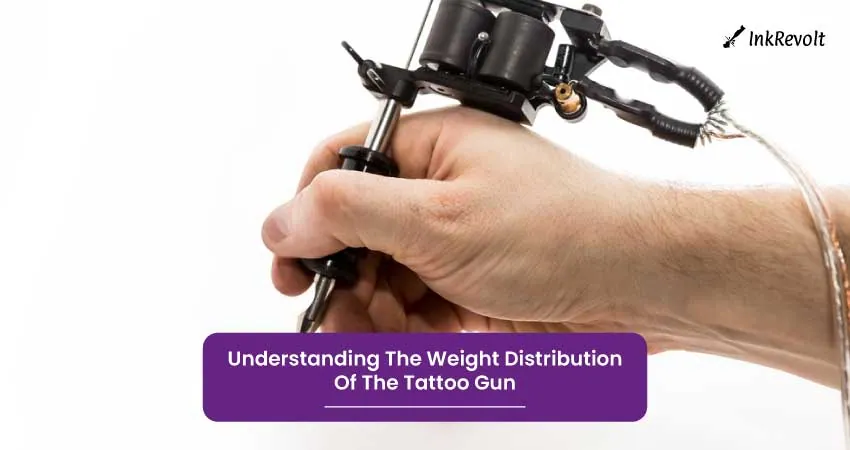
Weight distribution refers to the balance of weight between the front and back of the tattoo gun.
A well-balanced tattoo gun will be easier to handle, and the tattoo artist will experience less fatigue while using it. A poorly balanced tattoo gun can cause wrist strain, and hand fatigue, and make it challenging to create clean lines and shading.
The weight distribution of a tattoo gun depends on several factors, including the weight of the individual components, the placement of the components, and the grip’s shape and size. The needle, which is part of the tattoo gun that pierces the skin, is typically the heaviest component.
The grip, which the artist holds onto, is also an essential factor in weight distribution.
To achieve optimal weight distribution, tattoo gun manufacturers typically place the motor at the back of the gun, closer to the grip, and the needle at the front. This design places the majority of the weight closer to the artist’s hand, making the gun easier to control.
Another factor that influences weight distribution is the shape and size of the grip. A grip that is too thick or too thin can cause discomfort and affect the artist’s ability to control the gun. A grip that is too short can cause the weight to shift towards the front of the gun, making it more challenging to handle.
7 Must-Know Safety Tips For Handling A Tattoo Gun

If you are a tattoo artist or a beginner who wants to learn how to use a tattoo gun, you should be aware of the potential risks and hazards involved in handling a tattoo gun. It is essential to take necessary precautions to prevent any accidents or injuries while using a tattoo gun
Below are some essential safety tips for handling a tattoo gun.
Wear Proper Protective Gear
Before starting the tattooing process, it is important to wear the appropriate protective gear, including gloves, aprons, and goggles. These items will protect you from possible exposure to blood, ink, and other body fluids.
Sterilize Your Equipment
Ensure that all of your tattoo equipment, including the tattoo gun, needles, and tubes, are thoroughly sterilized before use. This will help to prevent the transmission of infections or diseases.
Keep Your Workspace Clean
Keep your workspace clean and organized. This includes using disposable paper or plastic covers for any surfaces that come in contact with the client’s skin, such as the tattoo chair or table. A clean and organized workspace is essential for minimizing the risk of infections or contamination.
Use High-Quality Ink and Needles
Using high-quality ink and needles will ensure a better outcome for the tattoo. It is crucial to check the expiration dates and storage conditions of these items before use.
Control Your Needle Depth
It is important to control the depth of the needle while using the tattoo gun. Make sure the needle is not inserted too deep into the skin, as this can cause unnecessary pain or damage.
Check for Allergies
Before starting the tattoo process, ask the client if they have any allergies. This will help you to choose the appropriate ink and avoid any allergic reactions.
Take Breaks
Taking regular breaks during the tattooing process is important to avoid fatigue and maintain focus. This will also help you to avoid any mistakes that can lead to accidents or injuries.
Handling a tattoo gun requires a high level of care and attention. Following these essential safety tips can help to minimize the risk of accidents or injuries while ensuring a high-quality tattoo.
Frequently Asked Questions
Should I wear gloves while holding a tattoo gun?
It’s always a good idea to wear gloves while tattooing, both for hygiene and to provide a better grip on the machine.
How much pressure should I use when holding the tattoo gun?
The amount of pressure you use will vary depending on the thickness of the skin and the type of needle you are using. Start with light pressure and gradually increase as needed.
Should I hold the tattoo gun with my dominant or non-dominant hand?
Most tattoo artists use their dominant hand to hold the machine, but some prefer to use their non-dominant hand for added control and precision.
Can I adjust the grip of the tattoo gun to fit my hand size?
Yes, many tattoo machines come with adjustable grips or can be modified to fit your hand size and comfort level.
How do I know if I’m holding the tattoo gun correctly?
A proper grip will allow you to move the machine smoothly and create clean, even lines. If you’re experiencing discomfort or struggling to control the machine, you may need to adjust your grip.
Last Thoughts
So, we hope that we answered the question-“How to hold a tattoo gun?” in the right way.
Holding a tattoo gun may seem like a simple task, but it requires patience, practice, and proper technique. It is important to hold the machine firmly with a relaxed grip, maintain a consistent angle, and use controlled movements.
A comfortable and stable grip will allow for more precise and accurate tattooing. As a tattoo artist, the proper holding of a tattoo gun will improve your skill, produce better results, and create satisfied clients. Practice and attention are key to perfecting your tattooing technique.
